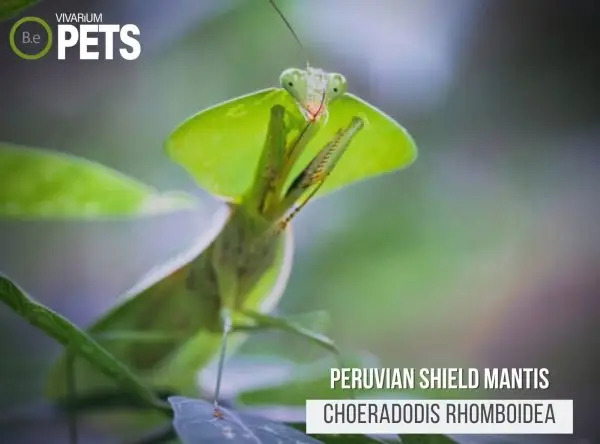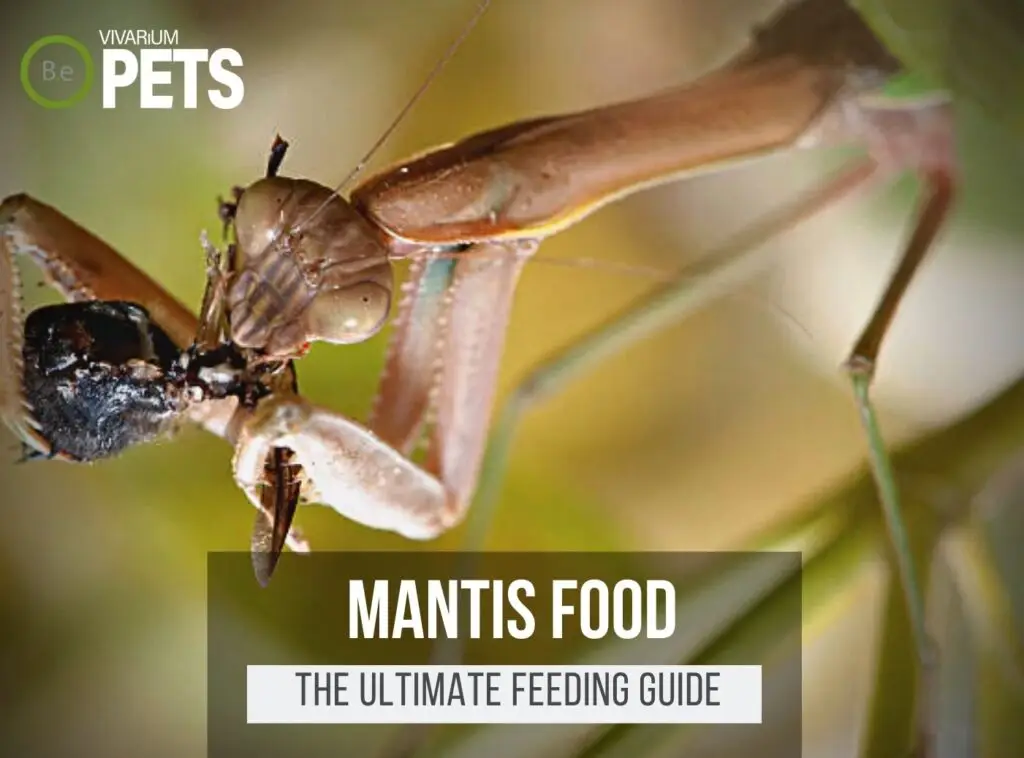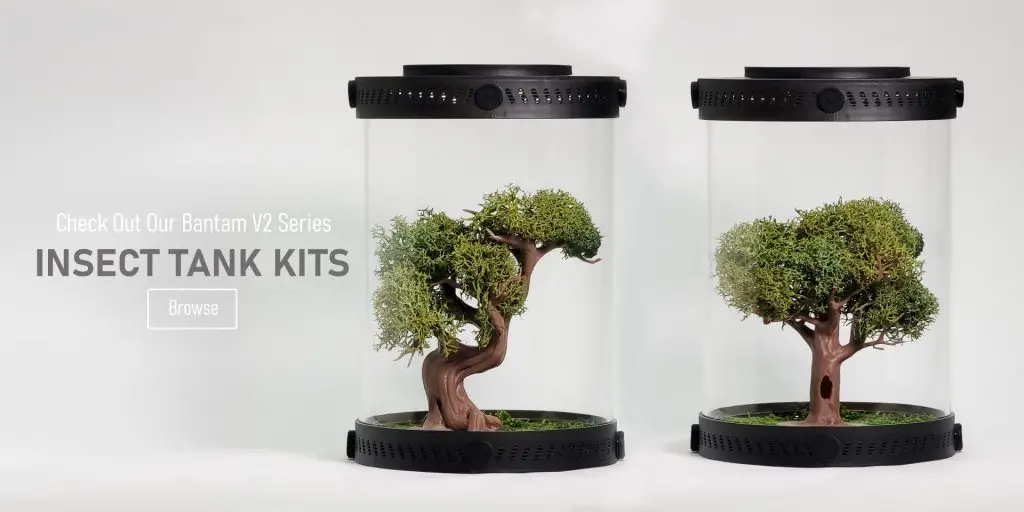If you are in search of an unconventional and distinctive pet, the Peruvian Shield Mantis is worth your consideration.
This tiny, attractive insect is a great pet for an experienced invertebrate keeper.
This Choeradodis rhomboidea guide will give you all the information you need to successfully house, feed, breed, and care for your pet praying mantis.
Learn all about the requirements necessary for keeping this exotic mantis healthy and happy and start your journey of mantis ownership!
| Characteristics: | |
|---|---|
| Common Name | Peruvian Shield Mantis, Rhomboid Mantis, Cobra Mantis |
| Family Name | Mantidae |
| Scientific Name | Choeradodis Rhomboidea |
| Use | Pets |
| Temperament | Non-aggressive |
| Lifespan | 6 to 10 Months |
| Diet | Insectivore |
| Adult Size | 1.7 to 3.5 in |
| Breeding Type | Egg Layer |
| Care Level | Moderate |
| Minimum Tank Size | 1 to 5 Gallons |
| pH | 7.0-8.0 |
| Hardness | Moderate |
| Temperature | 64-82°F |
Table Of Contents:
ToggleWhat Are Peruvian Shield Mantis?
The Peruvian Shield Mantis is a species of mantid found in certain parts of Peru.
Its scientific name is Choeradodis rhomboidea, and it is part of the family Mantidae.
Other common names for this species include the Cobra Mantis and the Rhomboid Mantis, about its specific shape.
These beautiful mantids can reach up to several inches in length and are distinguishable by the shield-like pattern on their pronotum.
Peruvian Shield Mantids are an active and fast species that make great pets for experienced invertebrate keepers!
What Does Peruvian Shield Mantis Look Like?
Mantidae is a small, slender species of mantis.
They have a unique and eye-catching appearance, with bright green or yellow coloring that stands out in any environment.
Adult specimens have a body size of 1.7 to 3.5 inches, with two sizable wings protruding from the thorax area.
They have long legs and mandibles, which are used to capture prey. Females have an ovipositor, which is used to lay eggs in suitable environments.
Each species can even display various stripes and patches that give them an attractive, ethereal appearance.
Benefits Of Using Peruvian Shield Mantis
The Peruvian Shield Mantis is a great addition to many types of vivariums.
This spectacular insect adds beauty and variety to your display while helping to keep your system in balance.
Having a mantis in your enclosure provides a natural form of pest control that helps to keep pests, like flies, at bay.
These mantids are easy to feed and do not require large amounts of space or attention, making them ideal pets for busy people.
Furthermore, Choeradodis rhomboidea is an excellent conversation piece and will surely impress any guest.
With proper care, your mantis will be a joy to have as part of your vivarium!

Peruvian Shield Mantis Facts
The Peruvian Shield Mantis is a small mantis species native to the South American tropics.
They are gentle and easily handled insect pets with a lifespan of almost a year.
In the wild, they feed on a variety of small insects, but can also eat soft fruits, such as banana, mango, and papaya.
Breeding is quite easy and can be done using standard twiggy branches or paper towels for the female to lay her ootheca.
Habitat
Choeradodis rhomboidea is native to the dry regions of Peru. They thrive in open, sunny spaces with low levels of vegetation.
The species is known to bask in the sun to warm up during the day, which is a behavior that helps them survive the cold temperatures of their native habitat.
They generally live in bush-like vegetation, often in crevices of rocks and near low-growing plants.
The species is also found in upland forests, grasslands, and near rivers, streams, and other water sources.
Due to its small size and natural camouflage, the Peruvian Shield Mantis is not easy to spot in its natural habitat.
It has a unique defense mechanism of folding its wings in rhomboid shapes when disturbed to make itself look like a dried leaf or twig.
This behavior helps the species avoid potential predation.
Create the perfect home for your mantis with our Customizable Mantis Enclosure Kits, designed to meet all their habitat needs.
Diet
The Peruvian Shield Mantis feeds on small insects and spiders in its natural habitat.
These include but are not limited to, grasshoppers, flies, ants, beetles, moths, and spiders.
Mantis tend to avoid eating larger prey items due to the increased risk of injury. In the wild, they mostly feed on small to medium-sized insects.
These mantises have an ambush predation strategy, meaning they lie in wait for their prey and then ambush them.
Temperament
Choeradodis rhomboidea is not an overly aggressive species.
They typically display calm and docile behavior and can be handled lightly with great care.
However, they can be startled easily and can produce a jumpy reflex whenever they feel alarmed. Thus, it’s important to handle them with caution and respect.
In addition, they tend to be fairly solitary and may display some skittish behavior when around other animals, such as other mantids or other insects.
This is normal, and the mantis should not be subjected to excessive stimuli, such as loud noises or bright lights.
If the mantis is exposed to such an environment, it could cause them to be stressed and agitated.
Remember to always treat them with respect and handle them with care whenever handling.
Lifespan
The lifespan of Choeradodis rhomboidea can vary depending on the environment that they are being kept in, but with proper and regular care, one of these beautiful mantises can live up to ten months.
The entire life cycle of the Peruvian Shield Mantis begins with the female laying a clutch of eggs known as “ootheca”, which can contain hundreds of eggs.
After a few weeks, the eggs will hatch and the baby mantis (called nymphs) will emerge.
A mantis will then go through several molt stages until they reach adulthood (after 6-8 molts).
Adult mantises have the longest lifespan, however, if not properly cared for, a mantis can live a very short life.
Breeding
Peruvian Shield Mantis are best kept in pairs to ensure reproduction.
When ready to mate, the male will grasp the female’s wings from below to perform a process called oviposition.
During this process, the male will deposit sperm into the female’s body which she will then use to lay her eggs.
Once the eggs are laid, they should be transferred to an egg sack which can then be kept in the tank with the parents.
The eggs will hatch in 1 to 2 weeks depending on the temperature and the humidity of the tank.
At this stage, the babies will be about 2 millimeters in size and they should be offered small food such as fruit flies to start their diet.
As the babies mature, they will eventually shed their skin and become unique adult mantes, complete with beautiful shield markings.
From this point on, they should be provided with standard adult food such as crickets and mantid flies.
Breeding of your Peruvian Shield Mantis should be easier with practice as you gain more experience.
Where To Find Peruvian Shield Mantis
If you’re interested in finding Choeradodis rhomboidea in the wild you’ll need to search the warm, tropical rainforests of South America.
These unique mantis species are usually found around tree trunks or leaves where they can blend in.
When going in search of a wild mantis be sure to abide by local laws and regulations, as it is illegal to capture or harm them.
If you’d rather buy a Peruvian Shield Mantis, you’ll be able to find them at certain online pet stores or breeders.
Make sure to do some research on the store or breeder before purchase, as reputable vendors are a must for any pet purchase.
Google ratings, third-party reviews, and asking other keepers in online forums are all useful tactics for finding trustworthy vendors.
Peruvian Shield Mantis Care
To properly care for Choeradodis rhomboidea, provide a tank that is adequately sized, with enough terrarium substrate to keep humidity at the right level.
Feed them appropriately according to their size and age. Sexing can be done using certain techniques.
Regularly inspect mantis for signs of diseases, parasites, or other health concerns.
Keep baby and juvenile mantids in separate tanks, as these are more vulnerable to environmental changes than adults.
Finally, make sure to provide the necessary conditions and diet to keep your mantis happy and healthy.
Tank Requirements
When it comes to establishing the ideal habitat for a Peruvian Shield Mantis, size is an important consideration.
A mantis should be provided with a tank of at least 1 to 5 gallons, with slightly taller tanks for larger mantis individuals.
The tank should be able to maintain a temperature of 64-82°F and require a relative humidity of 40%-70%.
A suitable cage substrate for the mantis should be something like coco fiber, moist peat moss, and vermiculite.
The pH should be between 7.0 and 8.0, while the hardness should be 4.0 to 8.0 dKH.
The tank will need two pieces of flimsy, natural foliage, as well as a shallow water bowl and hiding box.
Lights are not required, but if terrarium lights are present ensure they are positioned for no more than 12 hours a day.
What Does Peruvian Shield Mantis Eat?
Feeding Choeradodis rhomboidea is a vital part of caring for them properly.
The most common food sources for these small mantids are live insect prey like crickets, cockroaches, mealworms, small ants, and other small bugs.
They will also occasionally eat cut-up pieces of fruit, vegetables, or commercially prepared mantis food.
When feeding your mantis, it’s essential to provide them with prey items that are of an appropriate size; feeding prey that is too large for the mantis can be dangerous.
When you offer food, make sure it is no more than twice the size of the mantis’ head.
Feed your mantis 1-3 times per week, or as needed, and remove any uneaten food from the enclosure to prevent mold and disease.
If you’re looking for a more detailed approach to feeding these critters, be sure to check out my ultimate DIY Praying Mantis food guide. I give a more in-depth explanation of the best foods and my favorite recipe.
Best Tankmates For Peruvian Shield Mantis
Choeradodis rhomboidea is best kept alone, as they may become aggressive towards each other and can even cannibalize one another.
Large specimens are even capable of preying on smaller species such as roaches, ants, and other small invertebrates.
However, there are a few species that can safely co-exist with this mantis.
One excellent tank mate for the Peruvian Shield Mantis is the Dart Frog.
Dart frogs are easy to care for and are generally peaceful animals. They will not harm each other and will help keep pests in check.
Another good tank mate is the Pacman Frog. The Pacman Frog is an inquisitive amphibian and can often stay out of the mantis’ way.
This beneficial amphibian is a voracious eater, which can help to keep down the populations of potentially harmful pests such as ants and roaches.
While it is possible to keep other animals with the Peruvian Shield Mantis, it is best to avoid any small animals that could become food for the mantis.
Additionally, research the specific animals you wish to house in the same tank to make sure that they are compatible.
Conclusion
Now that you are familiar with the basics of Choeradodis rhomboidea care, it’s time to get to work creating an ideal habitat for your pet.
With the proper housing, food, and general care, your mantis will thrive for the year to come.
Have fun with your new pet and enjoy observing all its unique behaviors and interactions!
Create the ideal habitat for your praying mantis with our species-specific soil mixes and Insect Enclosure Kits. These products provide everything you need for a thriving Mantid habitat.



